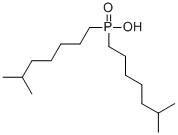BIS(2,4,4-TRIMETHYLPENTYL)PHOSPHINIC ACID
- CAS NO.:27661-42-3
- Empirical Formula: C16H35O2P
- Molecular Weight: 290.42
- MDL number: MFCD00216699
- SAFETY DATA SHEET (SDS)
- Update Date: 2022-08-15 17:36:58

What is BIS(2,4,4-TRIMETHYLPENTYL)PHOSPHINIC ACID?
The Uses of BIS(2,4,4-TRIMETHYLPENTYL)PHOSPHINIC ACID
Diisooctylphosphinic Acid functions as a surface passivating ligand in the synthesis of magic-sized cadmium selenide and cadmium telluride nanocrystals.
The Uses of BIS(2,4,4-TRIMETHYLPENTYL)PHOSPHINIC ACID
Diisooctylphosphinic acid (DiOPA) may be used in the following studies:
- As the surface passivating ligand in the synthesis of magic-sized CdSe and CdTe nanocrystals.
- As extractant in the extraction of Indium(III) from sulfate solutions.
- As ligand to investigate the solubility of four copper ligand systems in supercritical CO2.
- As acid ligand for the Supercritical fluid extraction (SFE) of divalent metals (Zn2+, Cu2+, Pb2+, Cd2+ and Cr3+) from sand and fly ash using CO2.
General Description
Diisooctylphosphinic acid is an organophosphorous acid.
Properties of BIS(2,4,4-TRIMETHYLPENTYL)PHOSPHINIC ACID
| Density | 0.916 g/mL at 20 °C (lit.) |
| refractive index | n |
| Flash point: | 108 °C |
Safety information for BIS(2,4,4-TRIMETHYLPENTYL)PHOSPHINIC ACID
| Signal word | Warning |
| Pictogram(s) |
 Exclamation Mark Irritant GHS07 |
| GHS Hazard Statements |
H319:Serious eye damage/eye irritation |
| Precautionary Statement Codes |
P305+P351+P338:IF IN EYES: Rinse cautiously with water for several minutes. Remove contact lenses, if present and easy to do. Continuerinsing. |
Computed Descriptors for BIS(2,4,4-TRIMETHYLPENTYL)PHOSPHINIC ACID
New Products
4-AMINO-TETRAHYDRO-PYRAN-4-CARBOXYLIC ACID HCL 4-(Dimethylamino)tetrahydro-2H-pyran-4-carbonitrile 4-Aminotetrahydropyran-4-carbonitrile Hydrochloride (R)-3-Aminobutanenitrile Hydrochloride 3-((Dimethylamino)methyl)-5-methylhexan-2-one oxalate 1,4-Dioxa-8-azaspiro[4.5]decane 5-Bromo-2-nitropyridine Nimesulide BP Aceclofenac IP/BP/EP Diclofenac Sodium IP/BP/EP/USP Mefenamic Acid IP/BP/EP/USP Ornidazole IP Diclofenac Potassium THOMAIND PAPER PH 2.0 TO 4.5 1 BOX BUFFER CAPSULE PH 9.2 - 10 CAP SODIUM CHLORIDE 0.1N CVS ALLOXAN MONOHYDRATE 98% PLATINUM 0.5% ON 3 MM ALUMINA PELLETS (TYPE 73) LITHIUM AAS SOLUTION 2-Bromo-1-(bromomethyl)-3-chloro-5-nitrobenzene 2-Bromo-3-nitroaniline N-(3-Hydroxypropyl)-N-methylacetamide 3-Bromo-6-chloropyridazine 4-ethyl-3-nitrobenzoic acidRelated products of tetrahydrofuran






You may like
-
 1-Methyl-6-oxo-1,6-dihydropyridazine-3-carbonitrile 98%View Details
1-Methyl-6-oxo-1,6-dihydropyridazine-3-carbonitrile 98%View Details
99903-60-3 -
 88491-46-7 98%View Details
88491-46-7 98%View Details
88491-46-7 -
 1823368-42-8 98%View Details
1823368-42-8 98%View Details
1823368-42-8 -
 2-(3-(tert-butyl)phenoxy)-2-methylpropanoic acid 1307449-08-6 98%View Details
2-(3-(tert-butyl)phenoxy)-2-methylpropanoic acid 1307449-08-6 98%View Details
1307449-08-6 -
 Ethyl 3-(furan-2-yl)-3-hydroxypropanoate 25408-95-1 98%View Details
Ethyl 3-(furan-2-yl)-3-hydroxypropanoate 25408-95-1 98%View Details
25408-95-1 -
 2-Chloro-5-fluoro-1-methoxy-3-methylbenzene 98%View Details
2-Chloro-5-fluoro-1-methoxy-3-methylbenzene 98%View Details
1805639-70-6 -
 1784294-80-9 98%View Details
1784294-80-9 98%View Details
1784294-80-9 -
 Lithium ClavulanateView Details
Lithium ClavulanateView Details
61177-44-4
Statement: All products displayed on this website are only used for non medical purposes such as industrial applications or scientific research, and cannot be used for clinical diagnosis or treatment of humans or animals. They are not medicinal or edible.